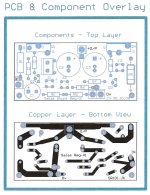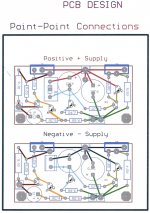For squeezebox, better to supply 1.2 and 3.3v separately, by replacing the regs on the squeezebox pcb.
If you search on the slimdevices forum, there are some posts with current draw. I think peak 350ma on the 3.3v supply.
If you search on the slimdevices forum, there are some posts with current draw. I think peak 350ma on the 3.3v supply.
For squeezebox, better to supply 1.2 and 3.3v separately, by replacing the regs on the squeezebox pcb.
If you search on the slimdevices forum, there are some posts with current draw. I think peak 350ma on the 3.3v supply.
Yes, it's technically (theoretically) much better, as it's true that the use of a super fast/ super low output resistance like Salas Shunt reg loses most of its interest when the 9V is actually supplying std quality linear Regs inside the squeezebox !
It's a totally different job however as it requires messing with the squeezebox internals and means finding a new casing....
...on the other hand, I always have doubts on the effect of better supply to power digital circuits anyway 😀, and changing the stock 9V supply by a better (linear) one has at least the advantage of avoiding injecting high frequency junk into the squeezebox.
We did have a reference on the Touch if of any interest.
http://www.diyaudio.com/forums/power-supplies/192625-sslv1-1-builds-fairytales-3.html#post2641282
http://www.diyaudio.com/forums/power-supplies/192625-sslv1-1-builds-fairytales-3.html#post2641282
...on the other hand, I always have doubts on the effect of better supply to power digital circuits anyway 😀, and changing the stock 9V supply by a better (linear) one has at least the advantage of avoiding injecting high frequency junk into the squeezebox.
IMO, uge gains are obtainable using separated PSU´s feeding independently all chips inside a digital circuit. This way you can avoid poluting each chip PSU line with junk coming from other chips.
But even better gains are obtainable if you use superegs instead of the stock industrial regulators.
My über CD53 with 11 superegs feeding independently all chips PSU line proves that.
Hi,
I lost track of the salas shunt story.
I have build a few on perf board that work great. Now I need some more psu's and am a bit tired of that work. Is there a group buy or the like for printed boards? I'm heading for version 1.2 (I think it was...) and voltages between 3.3 and 18 and need several boards.
Thanks i.a.,
Rüdiger
I lost track of the salas shunt story.
I have build a few on perf board that work great. Now I need some more psu's and am a bit tired of that work. Is there a group buy or the like for printed boards? I'm heading for version 1.2 (I think it was...) and voltages between 3.3 and 18 and need several boards.
Thanks i.a.,
Rüdiger
There are a lot of reading on how it is possible to improve the sonic performance of the Squeezebox Duet.
Commercial companies offer modifications in several steps too, in my opinion, sky-high prices. I have taken my inspirason to improvements from Mr. Lamizator. (squeezebox)
The common denominator for everyone, whether they are commercial or comes from private individuals, is that they throw their critical eyes on the included power supply.
Everyone experiences audible improvements by replacing the power supply to a better one.
Mr. Lamizator goes a step further by "improving" both the analog and digital controllers on the Duet circuit board. He does not go so far as Studiostevus proposes: To replace the regulators on the Duet board.
That is certainly a good idea. Although I will stay away from such intervention, as I have very bad experience with removing ICs from my DCX 2496. The danger in the process to destroy the print tracks are imminent. Possible that the printed tracks on the Duet is of better quality than on Behringer.
A change of the regulators, if done, I will leave it to someone who is more accustomed to SMD components. And my question is where to find leg compatible regulators for this purpose? On the board it is AVDD 33 (analog) and DVDD 33 (digital). Proposal to better types???
Eivind Stillingen
Commercial companies offer modifications in several steps too, in my opinion, sky-high prices. I have taken my inspirason to improvements from Mr. Lamizator. (squeezebox)
The common denominator for everyone, whether they are commercial or comes from private individuals, is that they throw their critical eyes on the included power supply.
Everyone experiences audible improvements by replacing the power supply to a better one.
Mr. Lamizator goes a step further by "improving" both the analog and digital controllers on the Duet circuit board. He does not go so far as Studiostevus proposes: To replace the regulators on the Duet board.
That is certainly a good idea. Although I will stay away from such intervention, as I have very bad experience with removing ICs from my DCX 2496. The danger in the process to destroy the print tracks are imminent. Possible that the printed tracks on the Duet is of better quality than on Behringer.
A change of the regulators, if done, I will leave it to someone who is more accustomed to SMD components. And my question is where to find leg compatible regulators for this purpose? On the board it is AVDD 33 (analog) and DVDD 33 (digital). Proposal to better types???
Eivind Stillingen
Last edited:
Liliya:
Here's what you asked from the original James print for your application:
R1=1R 3W
R2=120R
R3=120R
RC=27R
RS=0.1R 2W
R5=1K
R6=wire jumper
R7=27R
R8=120R
C1=47uF polar 25V
C2=470uF polar 25V high quality
C3=220uF polar 25V high quality
Q1=IRFP9240
Q2=BC560C
Q3=BC550C
Q4=IRFP9240
J1,J2,J3=K170BL (J1=weakest IDSS in your stash)
Vref connector (above j1)= Don't use a Zener, bad region for noise in your voltage. Try resistors 1-2k until you hit 9VDC out.
Here's what you asked from the original James print for your application:
R1=1R 3W
R2=120R
R3=120R
RC=27R
RS=0.1R 2W
R5=1K
R6=wire jumper
R7=27R
R8=120R
C1=47uF polar 25V
C2=470uF polar 25V high quality
C3=220uF polar 25V high quality
Q1=IRFP9240
Q2=BC560C
Q3=BC550C
Q4=IRFP9240
J1,J2,J3=K170BL (J1=weakest IDSS in your stash)
Vref connector (above j1)= Don't use a Zener, bad region for noise in your voltage. Try resistors 1-2k until you hit 9VDC out.
Attachments
Either the resistor I mentioned (#4508 last line), or leds red, green, yellow. Not other colors. They must be dropping 8.4V all together at 5mA. Choose some. Maybe a mix, 4 or 5.
On the paper LT1761 (500mA) - LT1763 (100mA) and ADP151 (200mA) look quite interesting, very low noise, the latter less expensive. Both TSOT 23-5 and available from mouser.And my question is where to find leg compatible regulators for this purpose? On the board it is AVDD 33 (analog) and DVDD 33 (digital). Proposal to better types???
End of OT 😀
Regarding regulator noise...
Can somebody who has simulated the Reflektor post an output noise spectral density graph for a 5V version (nV/sqrt(Hz) and frequency between 10Hz-100KHz).
Hope its not that complicated.
Can somebody who has simulated the Reflektor post an output noise spectral density graph for a 5V version (nV/sqrt(Hz) and frequency between 10Hz-100KHz).
Hope its not that complicated.
On the paper LT1761 (500mA) - LT1763 (100mA) and ADP151 (200mA) look quite interesting, very low noise, the latter less expensive. Both TSOT 23-5 and available from mouser.
End of OT 😀
Mouser doesn't stock Linear Tech parts, but Digikey does. You can also buy Linear parts from the company directly.
Regarding regulator noise...
Can somebody who has simulated the Reflektor post an output noise spectral density graph for a 5V version (nV/sqrt(Hz) and frequency between 10Hz-100KHz).
Hope its not that complicated.
Not complicated but I wouldn't put much weight on noise simulations. How quiet a supply does your circuit need?
Not complicated but I wouldn't put much weight on noise simulations. How quiet a supply does your circuit need?
I need a supply for a low jitter Tent clock in order to get close to the specified jitter, so possibly <100nV/SqrrtHz RMS noise (10Hz-100KHz). I'm planning to build a 40mA smd version of Reflektor for this.
Regarding regulator noise...
Can somebody who has simulated the Reflektor post an output noise spectral density graph for a 5V version (nV/sqrt(Hz) and frequency between 10Hz-100KHz).
Hope its not that complicated.
You can do this with FFT-free ware and a low noise preamp. Some have built Pete Millett's design: Soundcard Interface
I use the one which Walt Jung designed, substituting SSM2019 for the now obsolete SSM2017. Services This preamp's noise floor is about 0.9 nV/Rt Hz.
You can do this with FFT-free ware and a low noise preamp. Some have built Pete Millett's design: Soundcard Interface
Cool info. Thanks 🙂
I found this one: http://www.voxengo.com/product/span/
What should I donload ? I am using windows vista
Last edited:
Regarding regulator noise...
Can somebody who has simulated the Reflektor post an output noise spectral density graph for a 5V version (nV/sqrt(Hz) and frequency between 10Hz-100KHz).
Hope its not that complicated.
That one is with 2200uF Vref cap. Better for clock.
Attachments
- Status
- Not open for further replies.
- Home
- Amplifiers
- Power Supplies
- The simplistic Salas low voltage shunt regulator


